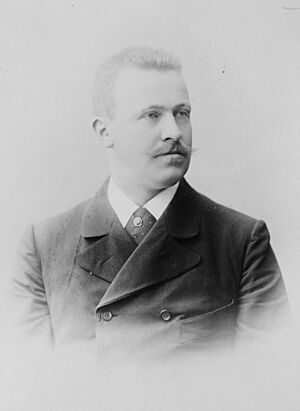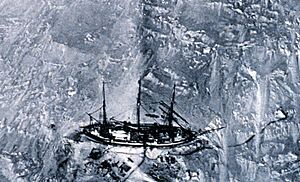Erich von Drygalski facts for kids
Quick facts for kids
Erich Dagobert von Drygalski
|
|
|---|---|

Pictured c. 1900–1920.
|
|
| Born | February 9, 1865 Königsberg, Province of Prussia, Kingdom of Prussia
|
| Died | January 10, 1949 (aged 83) Munich, American Zone, Allied-occupied Germany
|
| Nationality | German |
| Occupation | Geographer, Geophysicist, and polar scientist. |
Erich Dagobert von Drygalski (February 9, 1865 – January 10, 1949) was a German scientist. He was a geographer, which means he studied the Earth's surface and its features. He was also a geophysicist, someone who studies the Earth using physics. He was born in Königsberg, a city in what was then East Prussia.
Erich Drygalski was very smart. From 1882 to 1887, he studied mathematics and natural science at several universities. These included the University of Königsberg, Bonn, Berlin, and Leipzig. He earned his doctorate degree by writing about ice sheets in cold northern areas.
After his studies, from 1888 to 1891, he worked in Berlin. He helped with geodetic studies, which involve measuring the Earth's shape and size.
Drygalski also led two important trips between 1891 and 1893. These trips were supported by a science group in Berlin. During one trip, his team spent the winter of 1892-1893 in Western Greenland. He used the scientific information he gathered to become a professor of geography and geophysics. In 1898, he became an associate professor, and in 1899, a full professor in Berlin.
Exploring Antarctica: The Gauss Expedition
Erich Drygalski led the first German expedition to the South Pole. This journey was called the Gauss expedition. Its main goal was to explore the unknown parts of Antarctica located south of the Kerguelen Islands.
The expedition began in the summer of 1901 from Kiel, Germany. A small group of scientists stayed on the Kerguelen Islands. The main group continued their journey further south into the icy waters. Drygalski also made a quick stop at Heard Island. He collected the first detailed scientific information about the island's rocks, plants, and animals.
The ship, named Gauss, got stuck in the ice for almost 14 months. It was trapped until February 1903. Even with this challenge, the expedition made an amazing discovery. They found a new part of Antarctica, which they named Kaiser Wilhelm II Land. They also found a mountain there called the Gaussberg.
The expedition returned to Kiel in November 1903. After the journey, Drygalski spent many years writing about it. He also organized all the scientific information they collected. Between 1905 and 1931, he published 20 large books and two atlases. These books were full of details about the expedition. For his great work, he received the Royal Geographical Society's Patron's Medal in 1933.
Later Life and More Adventures
After his big Antarctic adventure, Drygalski continued his scientific work. From October 1906 until he retired, he was a professor in Munich. He also led the Geographic Institute there, which he helped create. He stayed in this role until he passed away.
In 1910, he joined another expedition. This time, he went with Count Ferdinand von Zeppelin to Spitsbergen, a group of islands in the Arctic. He also took part in other trips to North America and northeastern Asia. Erich Drygalski died in 1949 in Munich.
Places Named After Drygalski
Many places around the world are named in honor of Erich Drygalski. These include:
- Drygalski Island, an island in the Antarctic.
- Drygalski Fjord in South Georgia, a narrow inlet of the sea.
- An avenue in the southern part of Munich, Germany.
- The crater Drygalski on the Moon.
- Two glaciers: Drygalski Glacier (Antarctica) and Drygalski Glacier (Tanzania) on Mount Kilimanjaro.
An archive at the Ludwig Maximilians University keeps his important work and discoveries safe. Even a type of spider from South Africa, called Araneus drygalskii, is named after him. This spider was found using materials collected during the Gauss expedition.


